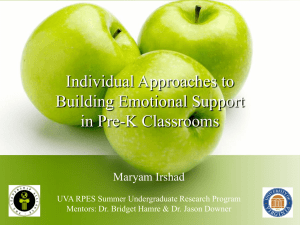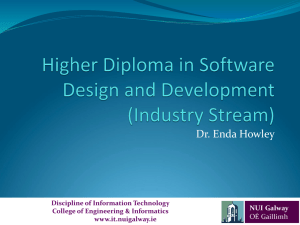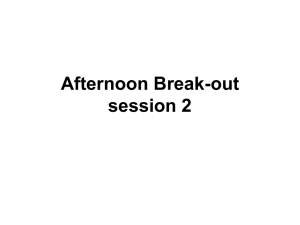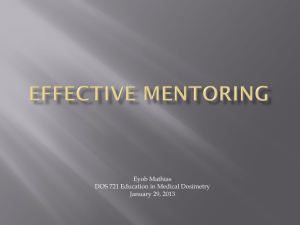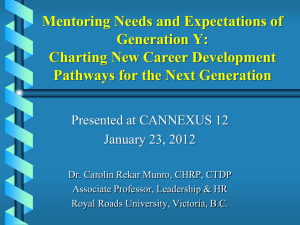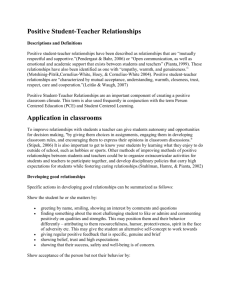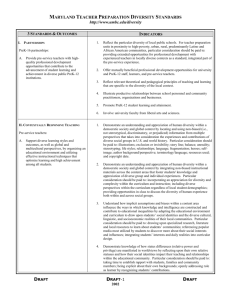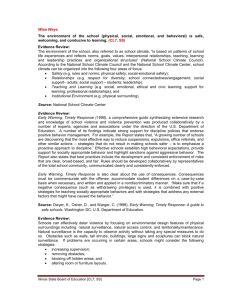Taiwan: Exc Teach
advertisement
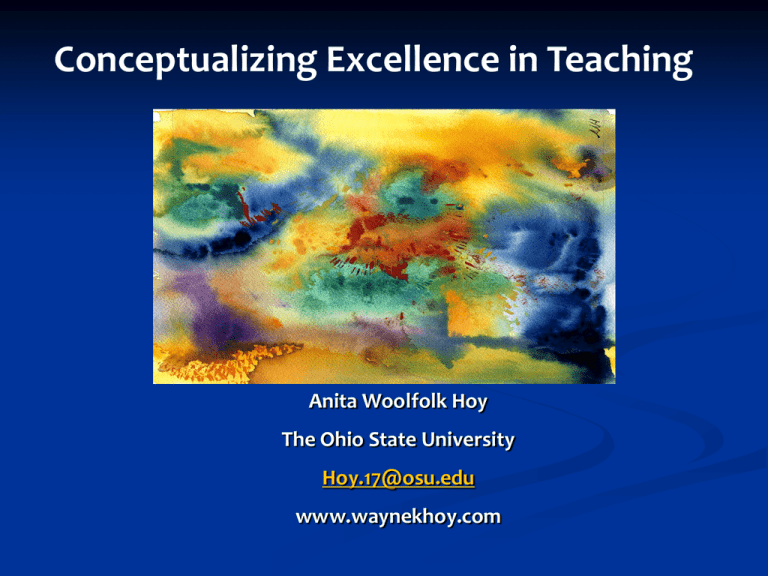
Conceptualizing Excellence in Teaching Anita Woolfolk Hoy The Ohio State University Hoy.17@osu.edu www.waynekhoy.com Overview • Pre-Service Teachers in Taiwan • Excellent Teaching=Student Learning • Research and models • Junior High: Engagement, Motivation • High School: Adaptive Teaching Pre-Service Teachers Wang, H. H. (2012). Adaptive and motivated: Psychological qualities of college students in teacher education programs in Taiwan. British Educational Research Journal, 38, 655–675. 2005 IHEDS National survey: 2349 pre-service teachers, 2349 not Self-report, 35-item Likert scale: “I am good at persuading others. “I feel confident.” “I am lonely and isolated.” “I do not cut class.” Results: Pre-service teachers: Better oral communication and interpersonal skills More open to diverse values and opinions Higher levels of self-esteem Lower levels of social isolation and depression More committed to academic work and future career Ready to become excellent teachers. What does that mean? Excellent Teaching Early Research Rice (1897): Teaching spelling Barak Rosenshine and Norma Furst (1973) Teacher Knowledge: Content and (today) Pedagogical Content Knowledge (learning) Teacher Clarity and Organization (learning) Teacher Warmth and Enthusiasm (liking, engagement) Excellent Teaching: Current Models and Conceptualizations Social-Relational Academic Optimism Robert Pianta and the CLASS model Instructional Charlotte Danielson’s Framework for Teaching TeacherWorks: 19 High-Leverage Practices Understanding by Design (Wiggins & Tighe) Importance of Relationships Interactions with adults are the scaffold for school success in: Self‐regulation, emotional self‐control, task orientation, persistence, motivation, engagement Cognitive outcomes, language, academic knowledge Instruction is, in part, a social process: Interactions with teachers are a (not only) “medium” Excellent teaching is embedded in relationships and interactions Interactions operate across all content Two Examples of the Importance of Relationships Longitudinal studies: Research by Robert Pianta and Colleagues Quality of the teacher–student relationship in kindergarten predicted academic and behavioral outcomes through the 8th grade (Hamre & Pianta 2001) Higher-level (not just basic skills) instruction and positive relationships with teachers increased math achievement for lower achievers (Crosnoe et al., 2010). Academic Optimism Hoy, W. K. (2012). School characteristics that make a difference for the achievement of all students: A 40-year academic odyssey. Journal of Educational Administration, 50, 76-97. Relational variables? Feedback GOAL THEORY Goals are: •Specific •Challenging •Attainable •Embraced Academic Emphasis Collective Efficacy Culture of Academic Optimism1 Trust in Parents & Students MOTIVATION •Responsibility •Effort •Persistence •Resilience COOPERATION •Students •Teachers •Parents Relational Trust2 Feedback 1Hoy, 2Bryk Tarter, and Woolfolk Hoy (2006) and Schneider (2002) Figure 3: A Model of the Dynamics of Student Achievement (ãHoy 2010) Student Achievement CLASS: Classroom Assessment Scoring System™ Dimensions of Successful Classrooms Remember--Interactions with adults are the scaffold for school success. Those interactions create: Emotional support Instructional support Classroom organization Climate Dimension Components Definitions and Examples Emotional Support Positive Climate Warmth, mutual respect, positive emotional connections between teacher and students Negative Climate (negative predictor of learning) Disrespect, anger, hostility Teacher Sensitivity Consistency and effectiveness in responding to students’ academic and emotional needs Regard for Students’ Perspectives Activities encourage student autonomy and emphasize students’ interests, motivations, and points of view Concept Development Activities and discussion promote higher-order thinking skills and cognition Quality of Feedback Consistency in providing specific, process-oriented feedback and back-and-forth exchanges to extend students’ learning Behavior Management Teachers’ effectiveness in monitoring, preventing, and redirecting misbehavior Productivity How consistently learning is maximized with clear activities and routines, teacher preparation, efficient transitions, and minimal disruptions Instructional Support Classroom Organization http://curry.virginia.edu/research/centers/castl/class http://www.teachstone.com See also Brown, J. L., Jones, S. M., LaRusso, M. D., & Aber, J. L. (2010). Improving classroom quality: Teacher influences and experimental impacts of the 4Rs Program. Journal of Educational Psychology, 102, 153–167. Instructional Framework for Teaching Charlotte Danielson (2013) “identifies those aspects of a teacher’s responsibilities that have been documented through empirical studies and theoretical research as promoting improved student learning. While the Framework is not the only possible description of practice, these responsibilities seek to define what teachers should know and be able to do in the exercise of their profession” (p. 3) Divides the complex task of teaching into the 22 components below, clustered into 4 domains of teaching responsibility: Planning and Preparing Classroom Environment Instruction Professional Responsibilities www.danielsongroup.org/article.aspx?page=frameworkforteaching Teacher Works National US project based at the University of Michigan With teachers, identified “a set of ‘best bets,’ warranted by research evidence, wisdom of practice, and logic.” Specific can be taught and observed www.teachingworks.org/work-of-teaching/highleverage-practices TeacherWorks 19 High-Leverage Teaching Practices 1. Making content (e.g., specific texts, problems, ideas, theories, processes) explicit through explanation, modelling, representations, and examples 2. Leading a whole-class discussion 3. Eliciting and interpreting individual students’ thinking 4. Establishing norms and routines for classroom discourse and work that are central to the subject-matter domain 5. Recognizing particular common patterns of student thinking and development in a subject-matter domain 6. Identifying and implementing an instructional response or strategy in response to common patterns of student thinking 7. Teaching a lesson or segment of instruction 8. Implementing organizational routines, procedures, and strategies to support a learning environment 9. Setting up and managing small group work 10. Engaging in strategic relationship-building conversations with student 11. Setting long- and short-term learning goals for students referenced to external benchmarks 12. Appraising, choosing, and modifying tasks and texts for a specific learning goal 13. Designing a sequence of lessons toward a specific learning goal 14. Selecting and using particular methods to check understanding and monitor student learning during and across lessons 15. Composing, selecting, and interpreting and using information from quizzes, tests, and other methods of summative assessment 16. Providing oral and written feedback to students on their work 17. Communicating about a student with a parent or guardian 18. Analyzing instruction for the purpose of improving it 19. Communicating with other professionals Thinking about Planning Understanding by Design Wiggins and Tighe (2006) Avoids the “twin sins” of planning Backwards design from big ideas and essential questions to evidence of understanding to teaching plan Junior High 1. How do teachers design learning environments and lessons to capture and hold student interest and encourage cognitive investment? 2. How do teachers help students become more self-regulating? Relationships: Roorda, D. L., Koomen, H. M. Y., Spilt, J. L., Oort, F. J. (2011). What else? What can teachers do? On TARGETT for Learning Task motivation Autonomy Rewards Grouping Evaluation & feedback Time for learning Teacher expectations Tasks for Learning Task value Attainment value: tied to needs/identity Intrinsic or interest value Utility value/reach goals--> future Authentic tasks Problem-based learning Task operations: risk & ambiguity Doyle’s Task Operations RISK High High Low Comprehension Opinion Doyle’s Task Operations A M B I G U I T Y Opinion Comprehension Difficult Memory Task or Routine Simple Memory Task or Routine RISK Low Difficult memory or difficult routine Simple memory or simple routine Supporting Autonomy Student choices Bounded choices Student choice on feedback Recognizing Accomplishments Authentic praise, specific and justified Personal improvement Cautions for use of rewards! Grouping Goal structures Individualistic Competitive Cooperative Jigsaw Inquiry Numbered Heads Think/Pair/Share Evaluation & Time Effects of evaluation Emphasize learning, not grades Self-evaluation Rationales and Rubrics Effects of time pressure Time for engagement Time pressure on tests Teacher Expectations Self-fulfilling prophecy Sustaining expectation effect Sources of expectations Tests Family Reputations Who is affected and when? Teacher Behaviors and Student Reactions Instructional strategies: Grouping, pacing, difficulty level Teacher-student interaction differences Quality and quantity of questions Amount of time to answer Number of teacher interruptions Nonverbal behaviors Strategies to Encourage Motivation and Thoughtful Learning Necessary Classroom Conditions Organized classroom Free from interruptions Safe-to-fail environment Challenging but reasonable work Authentic, worthwhile tasks Critical Student Questions Can I do it? Do I want to do it? What do I need to do to succeed? Do I belong in this class? 1. Can I do it? Building Confidence & Positive Expectations Match tasks to student ability level Move in small steps Clear, specific, attainable learning goals Stress self-comparison Communicate that academic ability can be improved Model good problem solving 2. Do I want to? Seeing the Value of Learning Older students: utility value, attainment value Younger students: intrinsic/interest value Intrinsic value Tie class activities to student interests Arouse curiosity Make learning fun (if possible) Use novelty and familiarity Seeing the Utility Value of Learning: Explain connections Provide incentives and rewards if needed Authentic tasks: Ill-structured Real world problems 3. Staying Focused on the Task Frequent assessments and opportunities to respond Have students create finished products Avoid heavy emphasis on grades and competition Reduce task risk without oversimplifying the task Model motivation to learn Teach particular learning tactics 4. Do I Belong? Relationships Beginning Teachers’ Motivation Strategies Reward/Punish Build Confidence Focus Attention Relevance Newby, J. T. (1991). Classroom motivation: Strategies of first year teachers. Journal of Educational Psychology, 83, 195-200. Resources http://p20motivationlab.org High School: Adapting Instruction Remember Relationships Remember Motivation Differentiated Instruction Flexible Grouping Joplin Plan Adaptive Teaching Matching support to student abilities and needs Relationships and Motivation Mentoring Ideas for Mentoring Take advantage of technology. Establish “email pals” for students, with retired adults or successful former students as their mentors. Download resources from NWREL’s National Mentoring Center, especially their schoolbased mentoring and tutoring materials (http://educationnorthwest.org/resource/360 . Let students know you believe in them. Set standards high and give critical feedback, but also provide support and encouragement. Showcase accomplishments of former students. Take the time to establish and maintain relationships. Don’t expect trust right away; you may have to earn it. Spend some time with students outside academics—before or after school, as part of clubs or extracurricular activities. Have some fun together. Find common interests. If you set up a more formal mentoring system, be sure participants are trained and monitored. Use materials from national mentor groups for training, for example, Elements of Effective Practice from MENTOR/National Mentoring Partnership http://www.mentoring.org/start_a_program/planning_and_design/. Have regular times to provide training and to deal with problems that may arise. Flexible Grouping Form and re-form groups based on accurate diagnosis of students’ current performance in the subject being taught. Groupings can be across grades (Joplin Plan) Make sure different groups get appropriately different instruction, not just the same material. Make sure teachers, methods, and pace are adjusted to fit the group’s needs. Vary more than pace; fit teaching to students’ interests and knowledge. Assign all groups research reports, but have some be written, and others oral or PowerPoint presentations. Organize and teach groups so that low-achieving students get appropriate extra instruction—not just the same material again. Make lower achieving groups smaller so students get extra attention. Make sure all work is meaningful and respectful—no worksheets for lower ability groups while the higher ability groups do experiments and projects. Discourage comparisons between groups and encourage a whole-class spirit. Keep the number of groups small (two or three at most) so that you can provide as much direct teaching as possible—leaving students alone for too long leads to less learning. http://www.eduplace.com/science/profdev/articles/valentino.html Bringing it All Together Lee, J., & Shute, V. J. (2010). Personal and socialcontextual factors in K–12 academic performance: An integrative perspective on student learning, Educational Psychologist, 45, 185–202. Synthesis of 150 studies Showing moderate to strong effect sizes linking personal/social factors to achievement. 4 factors: Student engagement Learning strategies School climate Social-Family factors Student Personal Factors Student Engagement Examples Students’ Behavior Make sure students attend classes, follow rules, participate in school activities. Students’ Minds and Motivations Design challenging tasks, tap intrinsic motivation, support student investment in learning, nurture student self-efficacy and other positive academic beliefs. Students’ Emotions Connect to student interest, pique curiosity, foster a sense of belonging and class connections, diminish anxiety, and increase enjoyment in learning. Learning Strategies Examples Cognitive Strategies Directly teach knowledge and skills that support student learning and deep processing of valuable information (e.g., summarizing, inferring, applying, and reasoning). Metacognitive Strategies Directly teach students to monitor, regulate, and evaluate their own cognitive processes, strengths, and weaknesses as learners; teach them about when, where, why, and how to use specific strategies. Behavioral Strategies Directly teach students strategies and tactics for managing, monitoring, and evaluating their action, motivation, affect, and environment, such as skills in: time management, test taking, help-seeking, note-taking, homework management Social-Contextual Factors School Climate Examples Academic Emphasis Set high expectations for your students and encourage the whole school to do the same; emphasize positive relations with the school community. Teacher Variables If possible, teach in a school with the positive qualities of collective efficacy, teacher empowerment, sense of affiliation. Principal Leadership If possible, teach in a school with the positive qualities of collegiality, high morale, and clearly conveyed goals. Social-Familial Influences Examples Parental Involvement Support parents in supporting their children’s learning. Peer Influences Create class and school norms that honor achievement, encourage peer support, and discourage peer conflict. Other References Corno, L. (2008). On teaching adaptively. Educational Psychologist, 43, 161– 173. Crosnoe, R., Morrison, F., Burchinal, M., Pianta, R., Keating, D., Friedman, S. L., & Clarke-Stewart, K. A. (2010). Instruction, teacher–student relations, and math achievement trajectories in elementary school. Journal of Educational Psychology, 102, 407–417. Hamre, B. K., & Pianta, R. C. (2001). Early teacher–child relationships and the trajectory of children’s school outcomes through eighth grade. Child Development, 72, 625–638. Roorda, D. L., Koomen, H. M. Y., Spilt, J. L., Oort, F. J. (2011). The influence of affective teacher–student relationships on students’ school engagement and achievement: A meta-analytic approach, Review of Educational Research, 81, 493-529.
